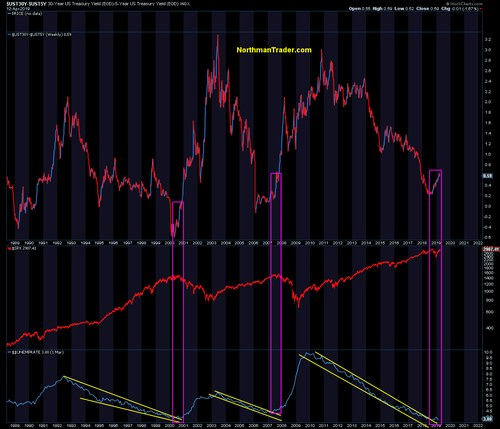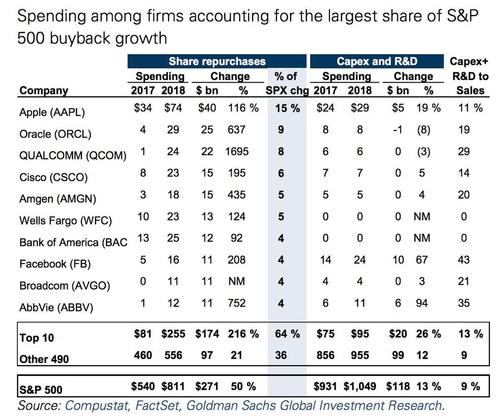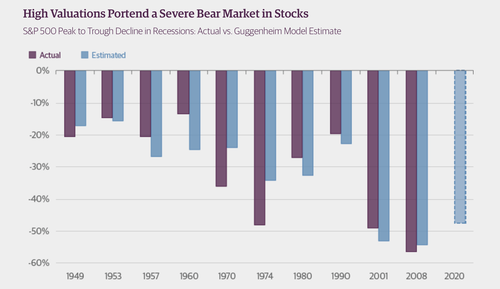Authored by Sven Henrich via NorthmanTrader.com,
Call Me Al
You can call me Al. By Al I mean Alan Greenspan. Oh I know, he has tons of detractors and critics and there’s a lot to be critical about. But before you go on a hate tirade let’s all have some respect. The man is 93 years old and I for one, if I make it to that age, would be glad to be just half as lucid as he is at this age. Respect.
Now what I’m talking about here is Alan’s interview on CNBC on Friday. Have a close listen as there are some interesting nuggets in there.
It’s actually fascinating for several reasons:
One: He acknowledges that a 10% $SPX rally correlates to 1% GDP growth. That’s how closely markets and the economy are linked. Hence the vested interest by the powers that be to keep levitating asset prices. No wonder then that President Trump is so eager for the Fed to go on the path of QE:
If the Fed had done its job properly, which it has not, the Stock Market would have been up 5000 to 10,000 additional points, and GDP would have been well over 4% instead of 3%…with almost no inflation. Quantitative tightening was a killer, should have done the exact opposite!
— Donald J. Trump (@realDonaldTrump) April 14, 2019
If only we had QE4 we could grow at 4% and the $DJIA would be at 31K-36K. Part of this statement is of course political calculus. After all someone has to be blamed if growth slows ahead of the US election, may as well blame the Fed, not self initiated trade wars or tax cuts. Yet the president of the United States has now squarely made central bank policy responsible for not only the direction of equity markets, but also their levels and directly linked the Fed’s policy to GDP growth. But in context of the upcoming 2020 election the tweet makes sense as he of course doesn’t want to see markets falter into the 2020 election.
Two: But Alan also acknowledges the larger economy is in massive trouble and by extension, markets. A short term boost he calls the current rally with growth faltering in the long term. Key reasons: Slowing growth in Europe and substantial fiscal problems related to entitlements which are rising and will continue to rise due to the demographic picture which can’t be changed. Add an “awful” political climate and you have a structural drag on the economy that Alan sees fading “dramatically”.
Three: The spread in the yield of the 30 year and 5 year. Alan Greenspan sees that as a key measure of the degree of willingness on the part of corporate management to make investments in the longer run.
Here’s that yield chart in correlation to past recessions:
That curve hasn’t inverted, but it exhibits behavior similar to previous pre-recession periods when unemployment was at a cycle low.
How willing is corporate management to make investments for the longer run? Given the pre-occupation with buybacks the action seems to suggest buybacks over CAPEX:
While 10 firms made up 31% of all buybacks in 2018 (according to Goldman) Apple has spent $74B on share buybacks, 2.5 times more than it spent on Capex + R&D. Overall buyback growth in 2018 was way higher than Capex growth.
Certainly says a lot about priorities. In conjunction with the charts posted this weekend in Mind the Gaps this screams 2020 recession risk to me and if so, buybacks will disappear quickly when that reality sinks in perhaps later in the year.
Before you think I’m a lone butty voice on this: Guggenheim is seeing a 2020 recession: “Our Recession Dashboard also continues to point to a recession starting by mid-2020.”
And with it their broader risk assessment for markets is pointing toward a 40%+ drawdown:
That’s a lot of GDP takedown given Alan Greenspan’s ratio outlined above.
The larger message: In essence Al is affirming my Combustion case, that it all will end badly and that the current rally will not last.
We’re playing the same tune. You can call me Al:
* * *
For the latest public analysis please visit NorthmanTrader. To subscribe to our market products please visit Services.
via ZeroHedge News http://bit.ly/2UnGkpU Tyler Durden



